I have been fascinated by the pictures of
brick temples of Bishnupur and its surrounding areas for years. I have been going through the Internet as well as some travel magazines to cull more information on the brick temples of West Bengal which seems to me as the unique to this State. I was surprised by the fact that there are at least one thousand brick temples - major and minor in West Bengal. These were mostly constructed during the period ranging from 17th to 19th centuries. Somehow, my trip to
Bishnupur always remained in the back burner. I had visited Calcutta (Kolkata)
umpteen times on official work which gave me the opportunity to visit some of
its well known tourist spots like Victoria Memorial, Maidan, Belur Math,
Dakshineshwar etc. But it was difficult to link the work related visits to Kolkata
with excursions from Kolkata for sight-seeing trip to Bishnupur.
My brother-in-law who has visited almost
all the tourist spots of India during his annual trips for the last 5 decades,
told me that during his trips to West Bengal, he missed out Bishnupur and other
places famous for the brick temples with terracotta plaques. My wife has been often
telling me that our next trip should include Kolkata. So this culminated into a trip to West Bengal
covering tourist spots in around Kolkata-Shantiniketan-Bishnupur-Kolkata route.
After taking into account the mutual convenience and avoiding peak tourist
season, we decided to undertake the trip during the second half of February
2014. Initially, we were four persons – I, my wife, my brother-in-law and his
wife for the trip. However, one of my brother-in-law’s close friends wished to
join us as it was his cherished dream to visit the birth place of Gurudev
Rabindranath Tagore in Kolkata and to visit Shantiniketan. Visiting these two
places was like a pilgrimage to him. Considering that we were all senior
citizens in the age group of 65-75 years, we decided to make our base at Shantiniketan and Bishnupur for 3 days each to cover the
tourists places around them. We also decided to hire a vehicle (SUV) from
Kolkata which would remain with us and drop us back to Kolkata. The guest
houses at both Shantiniketan and Bishnupur were booked in advance.
Mumbai-Howrah Mail (via Nagpur) reached
Howrah at its scheduled time of 4.55 a.m. We immediately got a taxi (Rs.400/-)
to drop us to Sunflower Guest House (6 kms) where we had reservation. Since the
check-in and check-out time at the guest house was 12 noon, we had to wait in a
reception area which fortunately had an attached toilet and bathroom. We did
not wait for long as the Guest House caretaker was kind enough to allocate two
rooms by 9.00 a.m. and another room by 11.00 a.m. (Semi-deluxe room with AC and
TV @ Rs.1720/-including tax). The rooms and toilets were clean though bathroom
cum toilet was very small. But for an overnight stay, it was good enough to
serve our purpose. Furthermore, the Guest House is located at central place off
Park Street. The staffs were polite and helpful. One of them arranged a vehicle
(Tavera) for us to take us to a few tourist spots of Kolkata.
Day-1
: In Kolkata
(i) Science
City
The driver of the vehicle (Tavera,
Rs.2000/- for 10 hours) picked us from the Guest House exactly at 11.30 a.m. as
promised. Our first in the list was Science City which none of us seen it in
our previous visits. A few months back, I had visited Nehru Science Centre in
Mumbai with my grandchildren and I was very much impressed by the number of
exhibits and the manner of presentations. Also the centre was kept neat and
clean with lot of greenery around. But after visiting Science City, Kolkata, I
am now more impressed with it as it has more space for exhibitions, probably
looks to me bigger both in terms of area as well as in terms of the variety
and number of exhibits. Because of a lot of open and green spaces, it is an
ideal place for a day picnic with children coupled with viewing the exhibits
and other shows. To see the place in details, one would require at least half a
day in Science City.
 |
| The side view of the Convention Centre, Science City, Kolkata. |
 |
| Science Park, Science City, Kolkata |
(ii)
Jorasanko Thakurbari
Jorasanko Thakurbari (Rabindranath Tagore’s
ancestral house) was constructed sometime in the 18th century by
Dwarkanath Tagore, Rabindranath Tagore’s grandfather. In my previous visits to
Kolkata, I did not visit the place as I was then not aware of the history
behind this thakurbari which I thought to be like any other mansions of
landlords of the Raj period. After knowing the history behind this thakurbari,
this time I made it a point to visit this place. The beauty of this calm and
serene place was marred by a narrow and dirty lane. However, once we were inside
the complex which is now a part of Rabindra Bharati University, there was a
stark contrast to what we had seen outside the complex. The garden and
buildings have been maintained neatly. There is museum dedicated to the life
and works of Rabindranath Tagore. It is located in a part of the mansion where
Rabindranath Tagore was born and breathed his last. A part of the museum has
dedicated Chinese and Japanese sections which exhibit the photographs of
Rabindranath Tagore’s visits to these countries as also his paintings connected
with these visits. The museum is very nostalgic as it rewinds the history of a
bygone era. Cameras, mobiles and big bags are not permitted to be taken inside
the museum. There are lockers available at the entrance to the museum to
deposits these items.
 |
| Jorasanko Thakurbari, the birth place of Gurudev Rabindranath Tagore, Kolkatta. |
 |
| Jorasanko Thakurbari. This portion which has now been converted into a museum was the residence of Gurudev Rabindranath Tagore. |
(iii)
Dakshineshwar Kali Temple
This was my third visits to one of the
largest temples of Kolkata which has been associated with Ramkrishna Paramhansa
and Swami Vivekanand. The sun was already on the western horizon as we reached
the temple. There was a large crowd both inside the temple complex as well as
at the banks of Hooghly River. Probably local people prefer to visit the temple
in the evening, pay their obstinate to Maa Kali and spend some time at the
banks of Hooghly River to watch the movements of boats with passengers and the
setting sun.
There was a big queue for the darshan of
Maa Kali. So we took the darshan from one of the side doors where the idol was
clearly visible. There are 12 Shiva temples facing the Maa Kali temple, with
each one having a black marble shivling. The atmosphere inside the temple
complex was serene without any chaotic condition generally associated with
popular temples. This is one of those temples in India which I like to visit
again and again where there is a perfect blend of nature and spirituality. We spent some time at the banks of Hooghly River to watch the
sunset. However, due to hazy conditions, the sun just got eclipsed before it
was to set in.
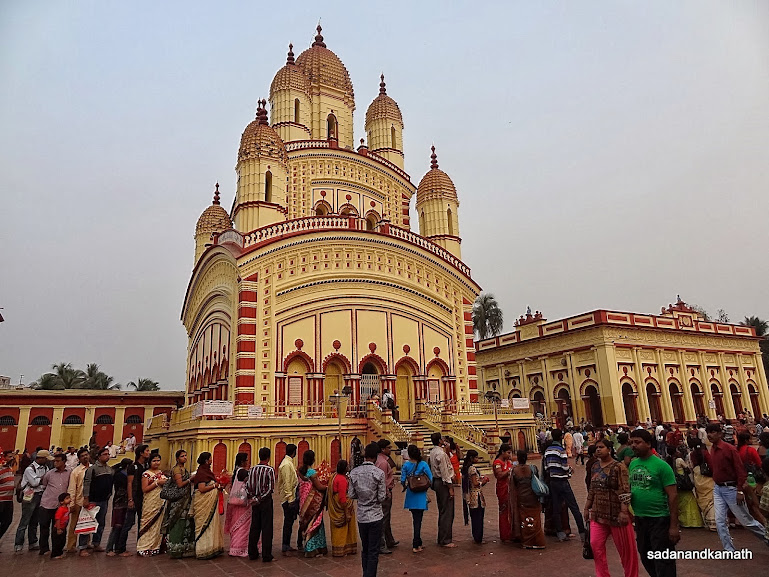 |
| Dakshineshwar Kali temple |
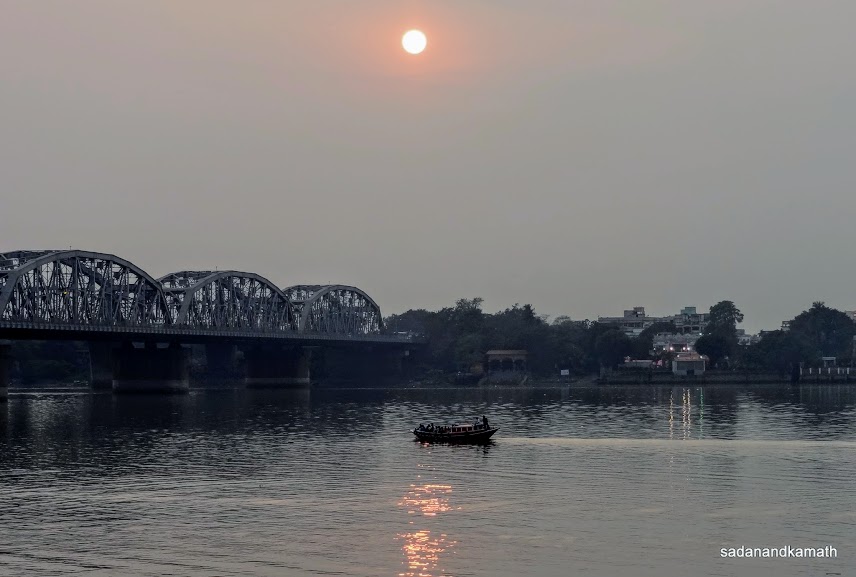 |
| Evening sun with Hooghly river flowing by the side of Dakshineshawar Kali temple, a 'confluence' of spirituality and nature. |
(iv)
Belur Math
Like Dakshineshwar, this was my third
visits to Belur Math. By the time we reached the Math, it was quite dark and
some arati (evening prayer) was going on inside the Math with hundreds of devotees and
visitors sitting and watching the arati with pin drop silence. Since there was no place to go inside,
we watched the arati as well as the idol from a side opening and returned to
the gate where there was a exhibition on the life of Swami Vivekanand on the
occasion of his 150th birth anniversary year. Photography is
prohibited inside the Belur Math complex.
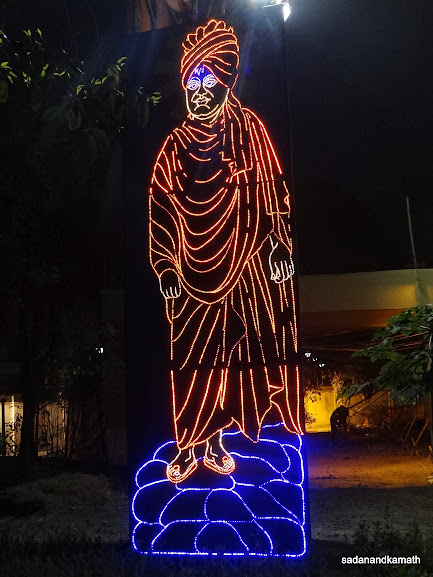 |
| Electronic statue of Swami Vivekanand inside Belur Math on the occasion of his 150th birth anniversary. |
We returned to Guest House at around 8.30
p.m. After freshening, we decided to eat at a hotel on a walking distance from
the Guest House. As claimed by the Guest House staff, the food was good and
cheap too.
Day-2
: To Shantiniketan via Kalna (210 kms)
(i)
Brick temples at Kalna
We were impressed with the driver and the
condition of Tavera which prompted us to engage him for the remaining 7 days of
our road trip. Another advantage with this driver was that he was fluent in both Hindi and Bengali. After negotiation, we agreed for Rs.155/- per hour (all
inclusive except parking and toll charges) without any restrictions as to the
daily kms run as well as the number of hours of driving. Of course, we ensured
that we completed our road journey before dark almost all days.
After checking out, we commenced our
journey to Kalna (92 kms) around 8.30 a.m. The journey was smooth as SH-6 was
well maintained. However, somewhere in the mid-point to Kalna, there was a
traffic jam. It turned out that there was a road blockade by the workers of a
political party as one of their worker was said to have been murdered. Without
wasting time, our driver drove through an alternate road. Calling it an
alternate road would be a misnomer as the it was more of a narrow dirt lane
just sufficient for a vehicle like Tavera to push through. After driving
through the serpentine lanes for about 20 kms, we finally reached the main road
bypassing the blocked portion of the road. In this process, we nearly lost one
hour. Rest of the journey was once again smooth. At Magra ‘Y’ junction, the
road to the right goes to Kalna while to the left goes to Bardhaman. We reached
Kalna by noon.
Kalna town, also known as Ambika Kalna
because the town has a holy temple of Siddheswari
Devi, a form of Maa Ambika or Kali was once part of Bardhaman royalty. Being
located at the banks of River Bhagirathi, it was a flourishing port town with
maritime trade. Most of the temples were constructed during 18th
century under the patronage of Maharaja of Bardhaman. There are many temples in
the town, but we concentrated on terracotta temples located on either side of
the road in Rajbari area. These temples are all within the walkable distance
from each other. On the one side of the road is a temple complex having
Pratapeshwar temple, Lalji temple and Krishna Chandraji temple as main temples.
All the three temples have delicate terracotta ornamentations but Pratapeshwar
temple though smaller in size has the most elegant terracotta ornamentations
all over it. This brick temple was constructed in 1849 in duel type with curvilinear
shikara like Odhisa temples. The terracotta plaques depict the stories from
Ramayan, Mahabharat and the social activities of that time. A roofless octagonal
Ras Mancha also made of bricks is located on the right side of this temple.
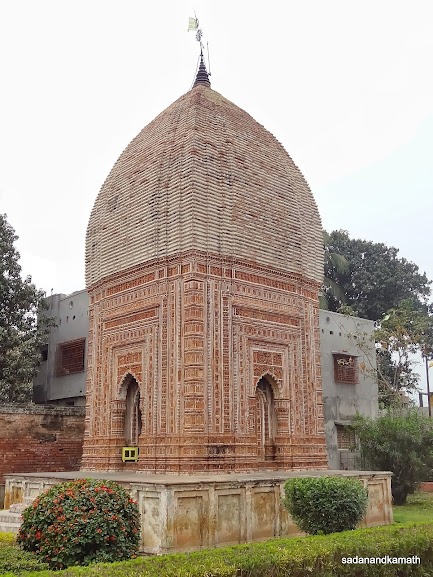 |
Pratapeshwar temple, Rajbari temple complex, Kalna
 |
Intricate and delicate terracotta ornamentations on a side wall of Pratapeshwar temple, Kalna.
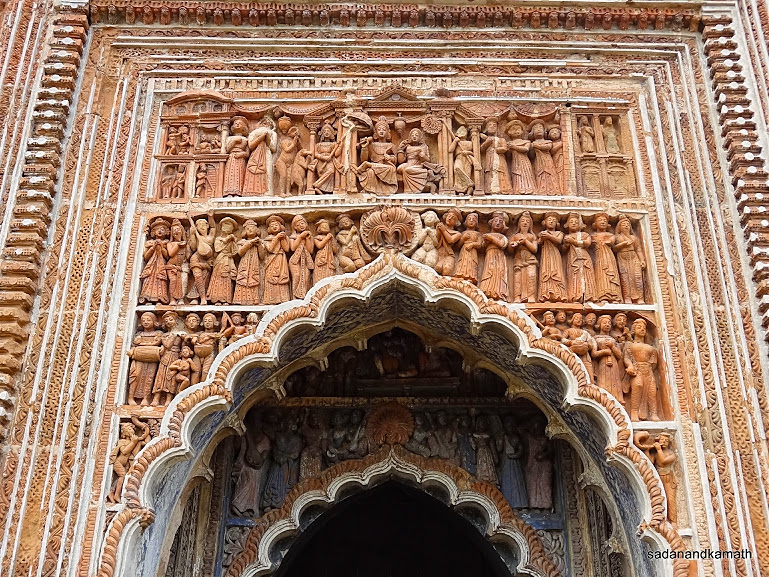 |
| Delicate terracotta ornamentations above one of the arched doors of Pratapeshwar temple, Kalna. |
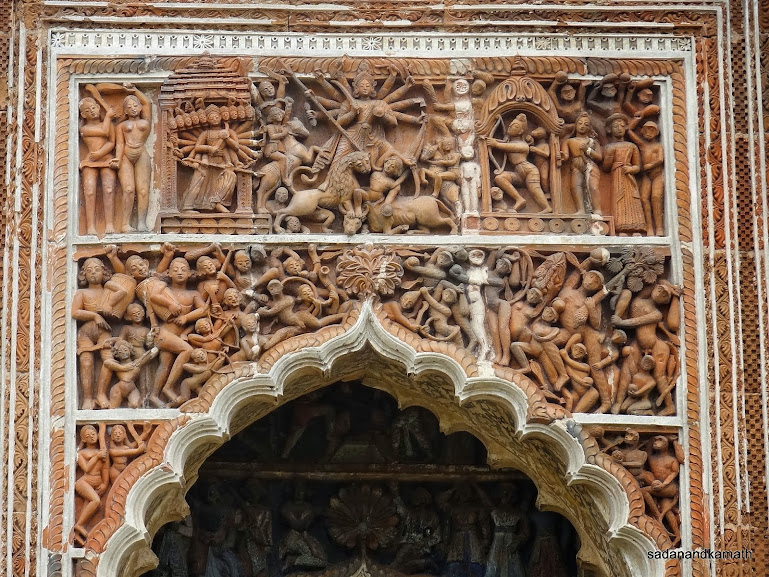
Delicate terracotta ornamentations above one of another arched doors of Pratapeshwar temple, Kalna.
 |
| The roofless octagonal Ras Mancha, Rajbari temple complex, Kalna |
The next in order of elegance (in my view)
is Lalji temple. It is the oldest brick
temple in this complex, having constructed in 1739. The temple is equivalent to
three story structure having 25 spires. The front view of the temple is
obstructed by a Mandapa of four sloped roof also constructed in bricks. The
terracotta ornamentations on this temple is very delicate and the styles
differs from those in Pratapeshwar temple. However, the terracotta plaques
depict the stories from Ramayan, Mahabharat and aspects of social activities as
seen on Pratapeshwar temple. One of the unique aspects of this temple is the
terracotta works at the meeting points (corners) of two walls. There is a
Goverdhan temple in front of the Mandapa.
The next in importance from the terracotta
ornamentation point of view is Krishna Chandraji temple located in the next
compound. The entry to the temple is from the complex itself. This temple is
said to have been built sometime during 1750-55. The architectural style of
this temple is more or less matches with that of Lalji temple. It is also a
three story structure having 25 spires. However, this temple does not have
terracotta plaques on all the walls. Another minor difference with Lalji temple
is that the Mandapa of this temple is small, more like a varandah and it has
three arched entrances.
In addition, there are five smaller temples
without much of terracotta works located in the complex. These are called
Pancharatna temples which are brick build temples on low platforms.
 |
| A general view of Lalji temple, Rajbari temple complex, Kalna |
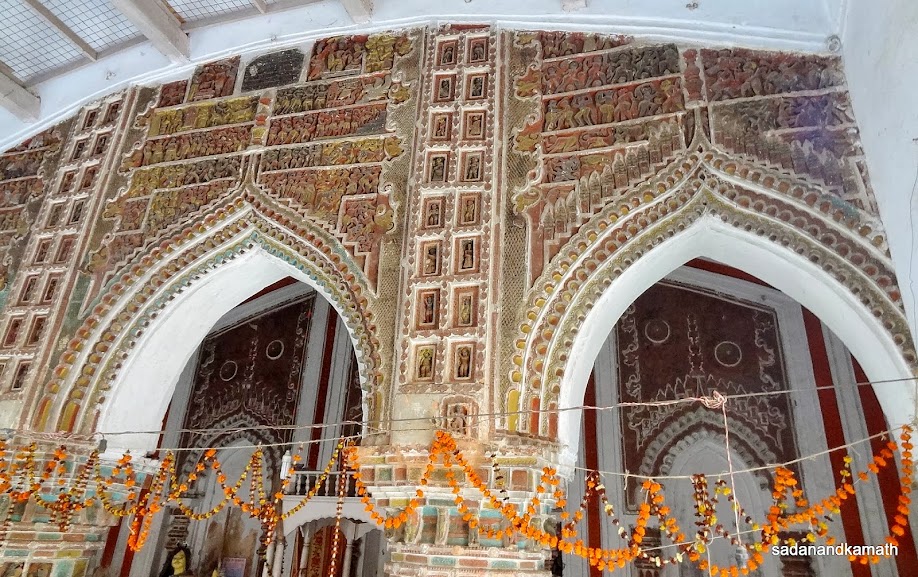 |
| Lalji temple archways leading to sanctum of the temple with delicate terracotta plaques above. |
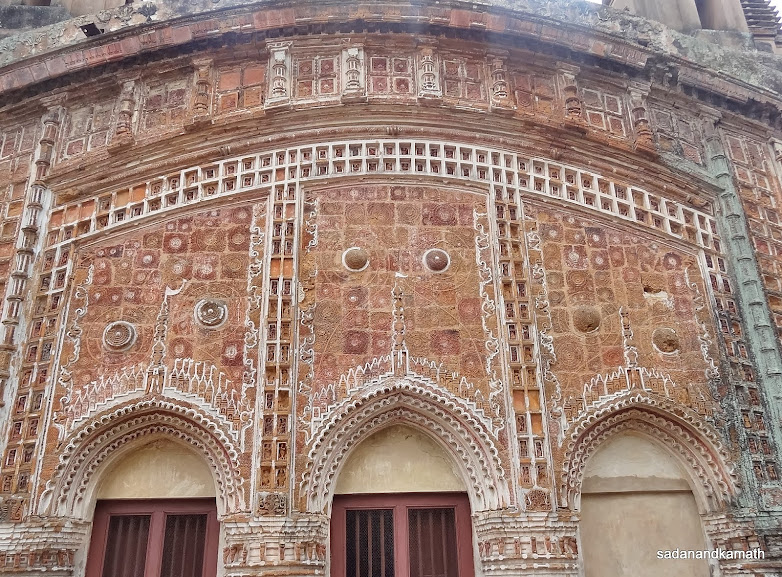 |
| Terracotta plaques on the side walls of Lalji temple, Kalna. |
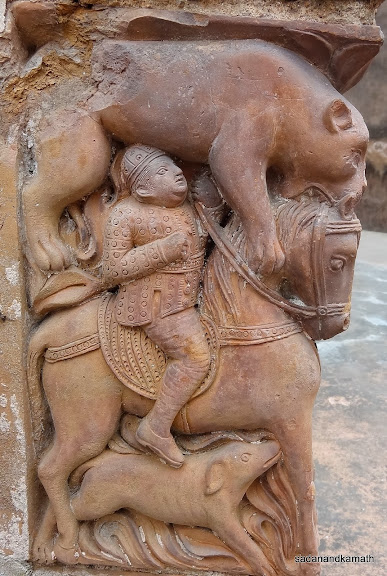 |
| Terracotta sculptures like this type adorn the corners of two walls of Lalji temple, Kalna. |
 |
| Terracotta plaque depicting the war bugles at the base of a wall of Lalji temple, Kalna. |
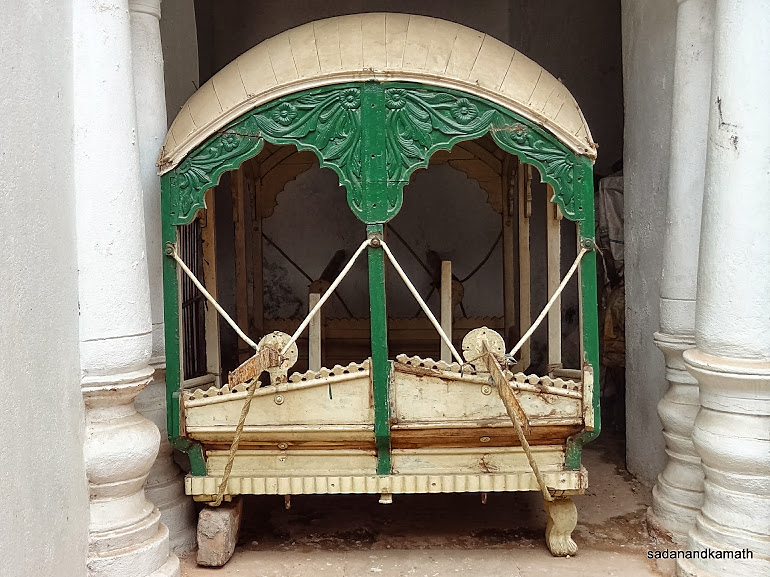 |
| A palanquin inside Lalji temple, Kalna |
 |
| Goverdhan temple in front of Lalji temple Nat Mandir, Kalna. |
 |
| A general view of 25 spire Krishna Chandraji temple, Rajbari temple complex, Kalna. |
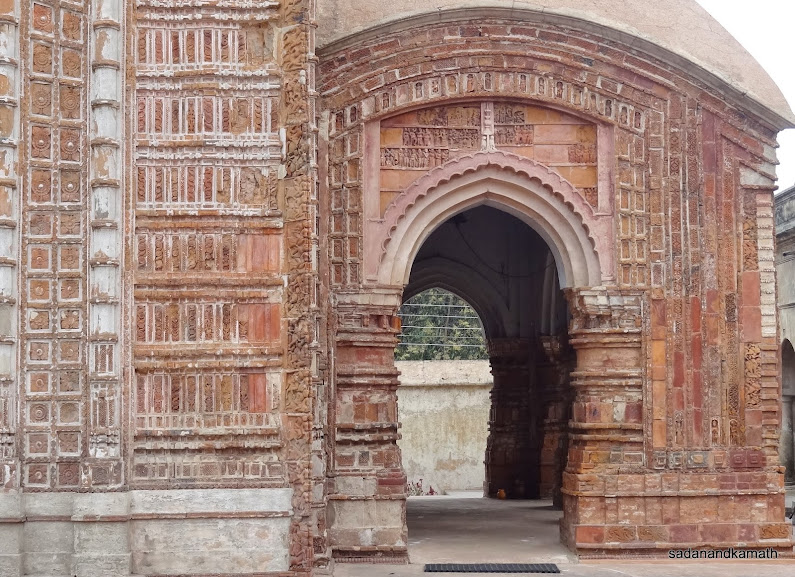 |
| Side view of three arched doors with terracotta plaques of Krishna Chandraji temple, Kalna. |
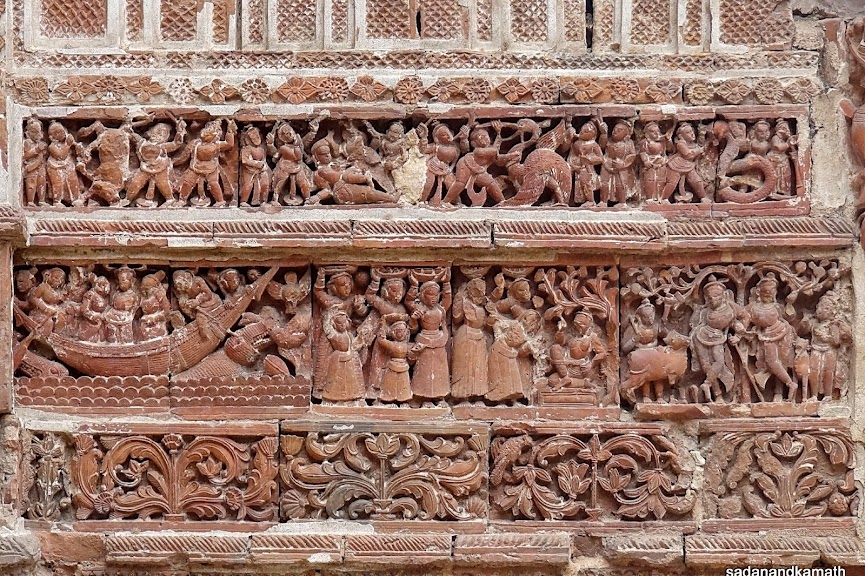 |
| Terracotta plaques depicting the social activities at the base of the front wall of Krishna Chandraji temple, Kalna. |
On the opposite side of the temple complex
is the famous Naba Kailash temple complex. This temple complex of 108 Shiva
temples in two circles – outer circle (74 temples) and inner circle (34
temples) was constructed by Maharaja of Bardhaman Tej Chandra Bahadur in 1809.
Shiva temples of outer circle have alternate black and white marble shivlings
while the temples of inner circle have only white marble shivlings. The two
circles are separated by a nicely maintain lawn and garden.
It was around 2.00 p.m. when we completed
the temple circuit around Rajbari. It was lunch time for us and to our utter
surprise, we found that almost all of the shops, hotels etc were closed. We came to know that
in the rural areas of Bengal, it is a practice to close the shops between 12
noon and 4.00 p.m. Luckily, we had carried enough food for such an eventuality.
We stopped our vehicle just at the outskirt of Rajbari where we found that one
tea shop was still open. We had theplas (thin rotis mixed with fenugreek
leaves) and sweet grated mango pickle to fill our belly followed by tea from
the shop.
 |
| Naba Kailash temple with a part of 74 Shiva temple in the outer circle, Kalna. |
 |
| A panoramic shot of a part of 34 Shiva temples in inner circle of Naba Kailash temple, Kalna. |
Sarbamangala
temple complex, Raiganj, (Bardhaman)
At around 3.00 p.m., our journey to
Bardhaman, our next destination, commenced. By now, the sky had become cloudy.
About a week before the commencement of our journey, I had seen the weather forecast
for Kolkata, Shantiniketan and Bishnupur on www.weather.com, which had
predicted rains or thunder showers in the evening for the last two places for
two days followed by drop in night temperature to a single digit. The
prediction seems to be coming out true now as it started drizzling. We reached
Sarbamangala or Durga temple near Raiganj (Bardhaman district) at around 4.45
p.m. As soon as we alighted from our vehicle, there were chorus of shouts from
the shopkeepers in the vicinity of the temple to buy offerings to Sarbamangala
from their shops. Some street dogs relaxing on the side of the shops seemed to be
bemused by the shouts of the shopkeepers as it disturbed their siesta. We did
not oblige them which infuriated the shopkeepers uttering some words in Bengali
which appears to me to be in bad taste.
We entered the temple complex and found
that we were the only visitor at that time. There was no force from priests to
do some poojas as it generally happens in some of the popular temples in India.
After the darshan of the main deity of the temple, all of us put cash in
donation box in lieu of purchase of offerings from the shopkeepers as we usually follow during visits to other temples in India. The temple
complex has five Shiva temples – Rameshwar, Kamleshwar, Mitreshwar,
Chandaneshwar and Indreshwar with white marble shivlings. There are terracotta
plaques on all these Shiva temples on the front side walls. Unfortunately, these
plaques have been coated with maroon colour paints depriving these terracotta
plaques of the aesthetic values.
 |
| Sarbamangala temple, Bardhaman. |
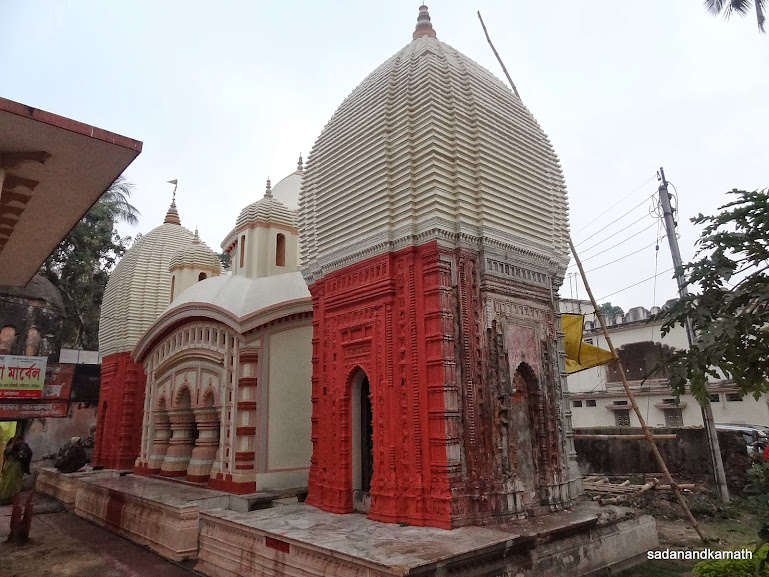 |
| Three Shiva temples, Rameshwar, Kamaleshwar, and Indreshwar in Sarbamangala temple complex, Bardhaman. |
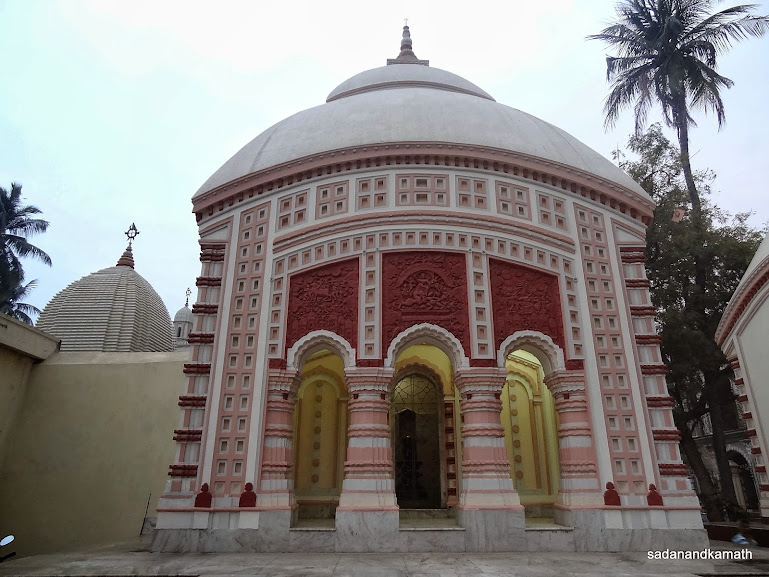 |
| Another Shiva temple, Mitreshwar in Sarbamangala temple complex, Bardhaman. |
We drove towards the main street of
Bardhaman city passing through the Curzon Gate. It was already dark at 5.30
p.m. The light showers with associated traffic jams made us to abandon the
visit to another temple and instead we started the return journey out of
Bardhaman city heading for the NH-2B for our final destination of the day,
Shantiniketan. We reached Rater Tara Diner Rabi (RTDR) Guest House located near
Vishwa Bharati Campus at around 7.30 p.m. in a damp atmosphere. The Guest House
was pre-booked and it did not take much time to settle in our respective rooms
(non-AC double-bedded room with TV @1500/- and 4 bedded AC room @2750/-, morning
tea and breakfast included) which were clean and spacious. We had dinner in the
Guest House’s dining room. The lunch and dinner are prepared in their kitchen
with prior orders.
Day-3
: In Shantiniketan
After travelling for almost the whole day
in the previous day, we had a leisure sight-seeing programme in Shantiniketan. There
was intermittent rains in the night bringing down the temperature to a single
digit in the morning. Though the rains had stopped, the weather was still
a bit cloudy. After breakfast, we commenced our sight-seeing tour of Shantiniketan. At
the bazaar area, we were told that hiring cycle rickshaws would enable us to pedal
through the complex. In the event, we
found later that it was all wrong information. Neither vehicles nor cycle
rickshaws are permitted inside the any complex of Shantiniketan. We could have
very well travelled in our own vehicle up to the gates of the various
complexes. Another thing we learned about the sight-seeing trip to
Shantiniketan was that except for Uttarayan complex,, all other complexes can
be viewed only from outside as the school and classes function in the morning.
Probably somewhat better time to take the tour is in the afternoon when entries
to some of the complexes get relaxed as the school and class timings are over.
But the best time to get a real feel of the Shantiniketan seems to be during Poush
Mela (last week of December) and Rabindranath Tagore Jayanti (May 7) when all
the complexes in Shantiniketan are thrown open to public. But during these events,
the place would be crowded and there could be problems in getting
accommodations in hotels and guest houses.
Since most of the complexes such as
Shantiniketan Ashram, Mrilanidevi Anand School, Upasana Griha (Prayer Hall)
Vishwa Bharati University, Chhatimala tree were to be seen from outside, we
completed the Shantiniketan tour in about 2 hours. A bulk of 2 hours were spent
inside Uttarayan complex. Bichitra Bhavan, the museum depicting the life and
works of Rabindranath Tagore took about 30 minutes and strolling and visiting
other bhavans (mansions) like Udhyana,
Konarak, Shyamli, Punascha, Udichi etc took another 30 minutes. It was a visit
of rewinding the history of Tagore family. It was a good feeling to visit these
bhavans where Rabindranath Tagore wrote poems, composed music and did
paintings. We could also visit a part of
Kala Bhavan to see murals. However, major segments of Kala Bhavan were out of
bound for tourists as the classes were going on.
After the completion of the visit to
Shantiniketan complexes, my admiration for Gurudev Rabindranath Tagore as a
human being increased many folds. I would say that no amount of readings books
on Rabindranath Tagore would make one fully understand his personality as
visiting Shantiniketan.
 |
Rater Tara Diner Rabi ( meaning Star at night, sun in the day) Guest House, Shantiniketan where we stayed for 3 days.
|
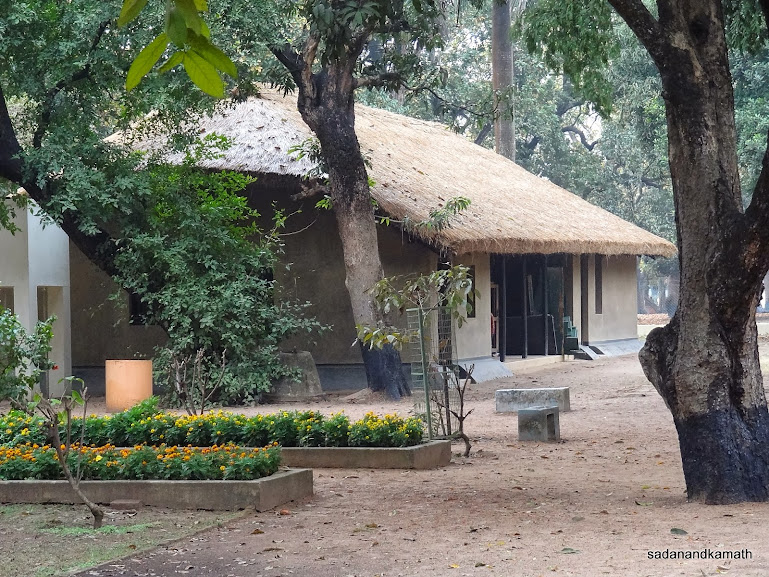 |
| Shantiniketan Ashram: This hut is used for initiation of fresh batch of students into the school. |
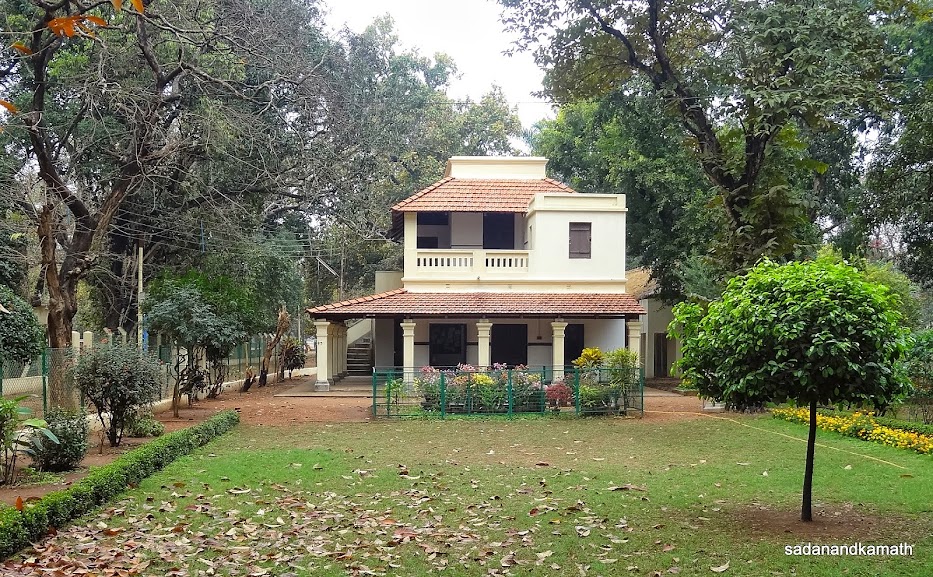 |
| Mrinalini Devi Anand School, Shantiniketan Ashram. |
 |
| The largest banyan tree in Shantiniketan Ashram. |
 |
| Upasana Griha (Prayer Hall), Shantiniketan Ashram. |
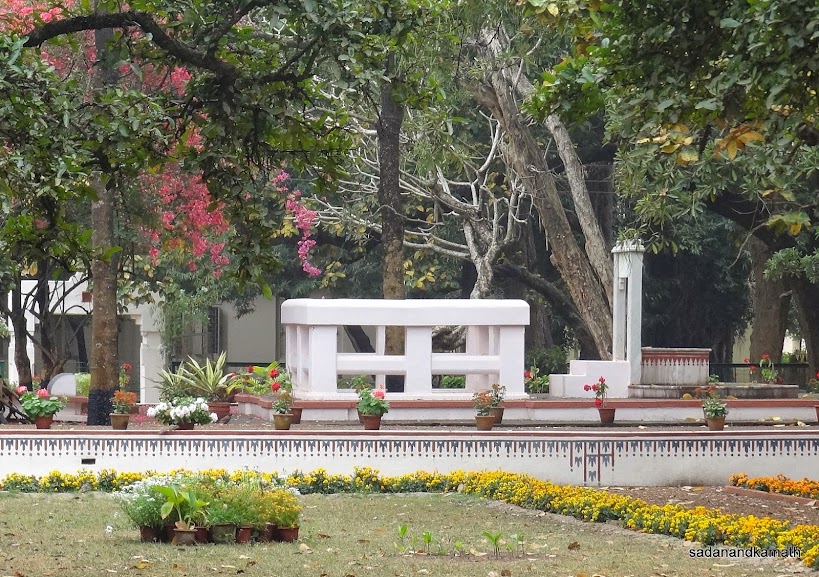 |
| Chhatimtala tree (enclosed with white structure below which Gurudev Rabindranath Tagore used to sit and get inspirations to write poems, stories, music etc. |
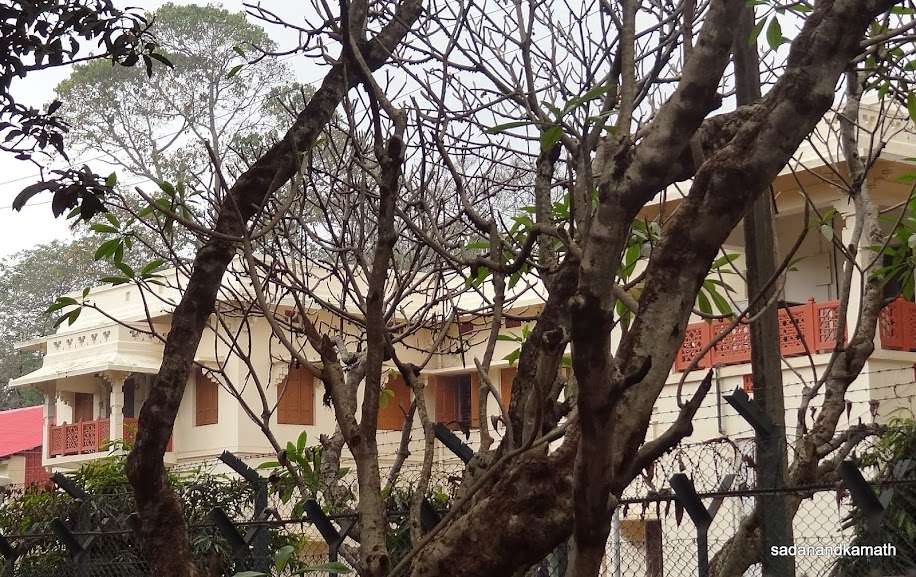 |
| Bichitra Bhavan in Uttarayan Complex which has been converted into a museum on the life and works of Rabindranath Tagore. |
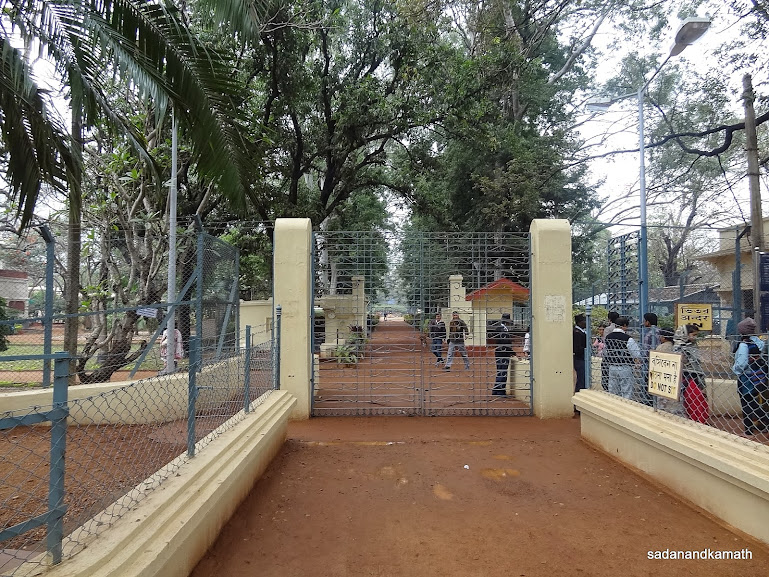 |
| The main gate leading to Uttarayan Complex, Shantiniketan. |
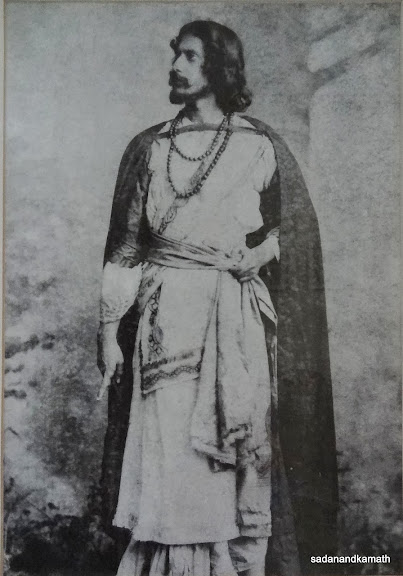 |
| Rabindranath Tagore in younger days in a Bengali drama 'Valmiki Pratibha'. |
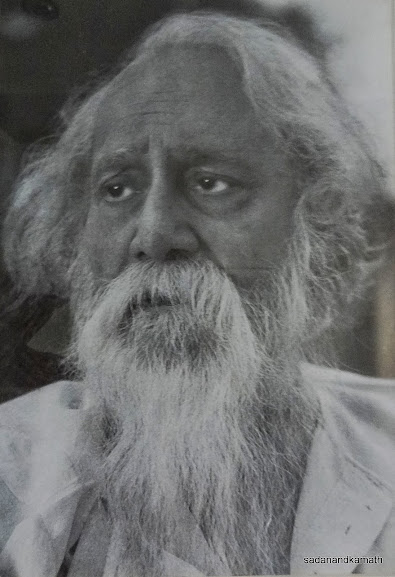 |
| Rabindranath Tagore in a pensive thought. |
 |
| Murals adorn the walls of one of the rooms of Kala Bhavan, Shantiniketan. |
In the afternoon, we visited the other side
of Shantiniketan – Prakriti Bhavan, a museum of natural arts. It is located
about 4 kms from Uttarayan complex. However, one has to drive on dirt gravel
road which passes through forest cover to reach the place. The museum is in two
buildings which houses the sculptures naturally evolved through rocks and wood
fossils. At the entrance to the Prakriti Bhavan complex, there is a Sculpture
Garden displaying natural rocks and wood fossils resembling various shapes such
as Lord Ganesh, Reclining Buddha, Caterpillar etc. The motto of the Prakriti Bhavan museum is
nature’s creativity and human beings’ aesthetic responses to them.
Opposite Prakriti Bhavan, there is a Deer
Sanctuary and a tank where some of migratory birds arrive in the winter. There is
also a big statue of sitting Buddha in the vicinity of Deer Sanctuary. Another
2 kms of drive took us to Amar Kutir where handicrafts by tribal population made from leather, jute
cloth, wood etc. are sold. One can observe the process of manufacturing
them in workshops inside the complex. The prices are much cheaper than what we
get similar items in Mumbai. We purchased some items like leather bags, pouches,
decorative boxes etc.
Our last destination of the day was
Sriniketan complex, a part of the Vishwa Bharati which was set up by
Rabindranath Tagore to help create rural reconstruction. Unfortunately, being
Sunday, the complex was closed. We returned to our Guest House at 2.30 p.m.
without having lunch as all the shops and hotels were closed during 12 noon to
4.00 p.m. The Guest House cook obliged us by quickly preparing rice, daal,
rotis and one vegetable item. By 3.30 p.m. we completed our lunch and spent
rest of the day in our rooms as it has already started drizzling. It rained
intermittently, becoming heavy in the night with thunder and lightning.
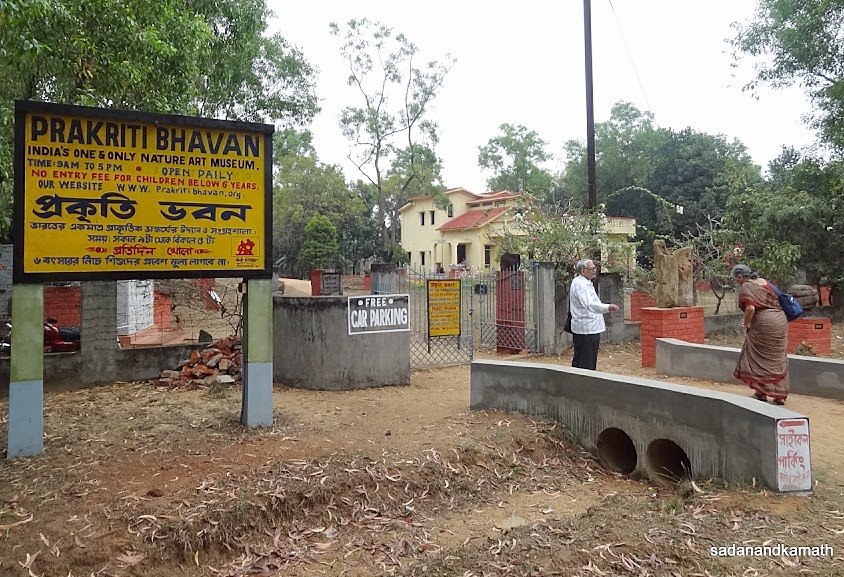 |
| Prakriti Bhavan entrance, Shantiniketan. |
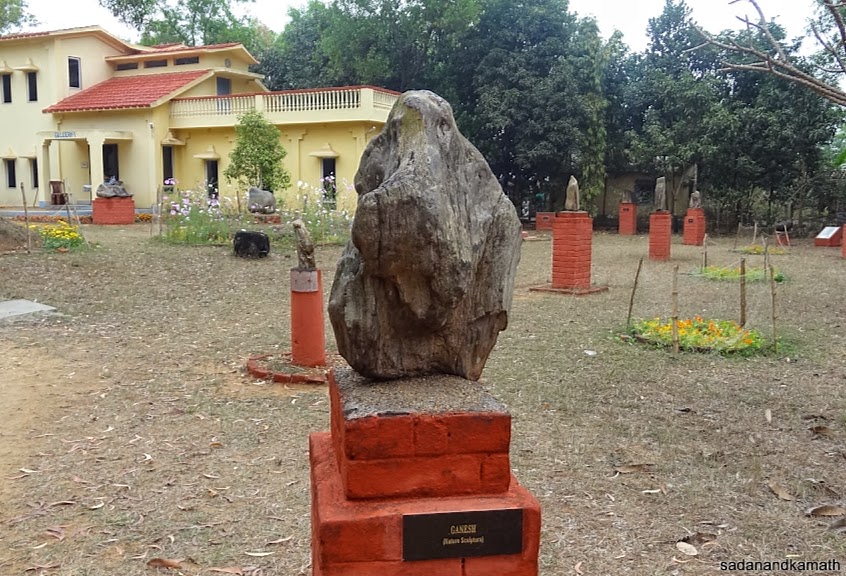 |
| Prakriti Bhavan - Natural creation of Lord Ganesh in Sculpture Garden. |
 |
| Prakriti Bhavan - Image of the sleeping Buddha in natural rock formation. |
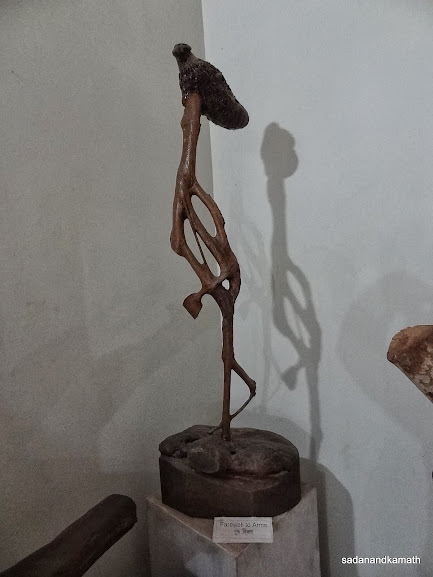 |
| A natural formation on dried branches depicting 'Farewell to Arms'. |
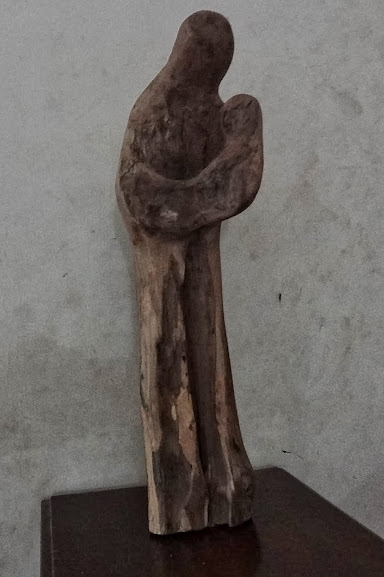 |
| Naturally formed 'Jesus holding a baby' on a tree trunk. |
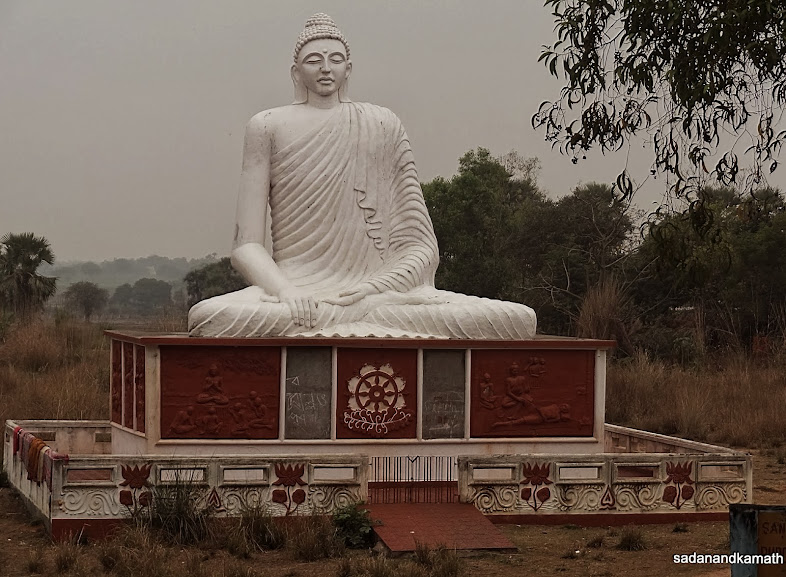 |
| Statue of sitting Buddha opposite Prakriti Bhavan. |
Day-4
: To Surul and Barakar and back to Shantiniketan (Total 240 kms)
The schedule for the day was for visiting
two places but the distance to be covered was more than 200 kms to and fro.
After breakfast, we commenced our journey, first to Surul at around 9.00 a.m.
Surul is hardly 5 kms from Shantiniketan. After the overnight rains, it was a
bright sunny morning. But with this, it brought the wintry cold weather. But as
the day progressed, the weather became pleasant.
The first halt at Surul was a Rajbari
belonging to Sarkar family. We entered Rajbari with the usual expectation that
there would the temples inside. But it was not. The courtyard of the Rajbari
had a hall in a nat mandir style and a multi-pillared hall in front of it. Even
with poor maintenance, the multi-pillared hall looked elegant. The hall was the
venue of the annual Durga Pooja during the bygone era of zamindar but this tradition continues even now. We saw inside the hall a model of
straw covered Maa Durga and other deities. By and large, the Rajbari is in
desolate condition. Adjacent to the Rajbari
is a small temple complex comprise
Laxmi-Janardhan (Vishnu) temple of 5 spires with 3 arched doors and twin Shiva
temple in duel style. The facade of Vishnu temple is full of terracotta
ornamentations. However, other three walls of the temple are plain. The twin
Shiva temples seems to be the renovated ones with freshly coated white and
brown colour. There is not much of the terracotta work on these two temples.
A further short drive from Sarkar Rajbari
took us to a obscure temple complex in Supur having two Shiva temples raised on short
platforms. They are located one after another but the architecture differs
considerably giving an impression that these two temples may have been
constructed at different time. The single spire temple at right was hexagon in
shape having delicate terracotta ornamentations on all its six sides. The
temple at the left was with a duel type architecture not having much terracotta
ornamentations except the top of the door.
 |
| A multi pillared hall (or nat mandir) in a Rajbari of Sarkar family. |
 |
Frontage of Laxmi-Janardhan temple, Surul Rajbari.
|
 |
| Delicate terracotta ornamentation depicting the battle of Ram and Ravan above the archway of Laxmi-Janardhan temple, Surul Rajbari. |
 |
| Terracotta depicting Ravan's court on a top portion of frontage of Laxmi-Janardhan temple, Surul Rajbari. |
 |
| Twin Shiva temples by the sides of Laxmi-Janardhan temple, Surul. |
 |
| Another twin Shiva temples in Supur with different architectural style, the right side one being in haxagon with extensive terracotta plaques. |
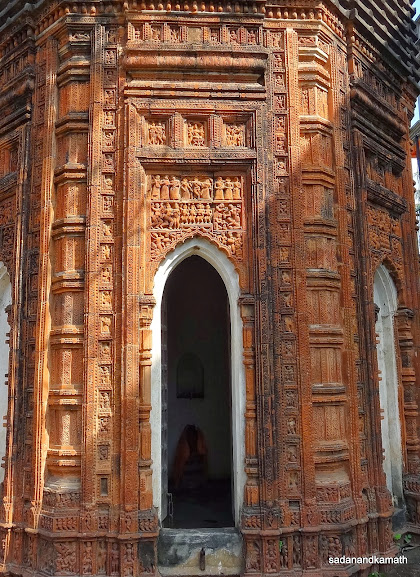 |
| The terrocotta plaques on the front side of the Shiva temple, Surul. |
 |
| Terracotta plaques depicting some events of celeberations above the arched door of Shiva temple, Surul. |
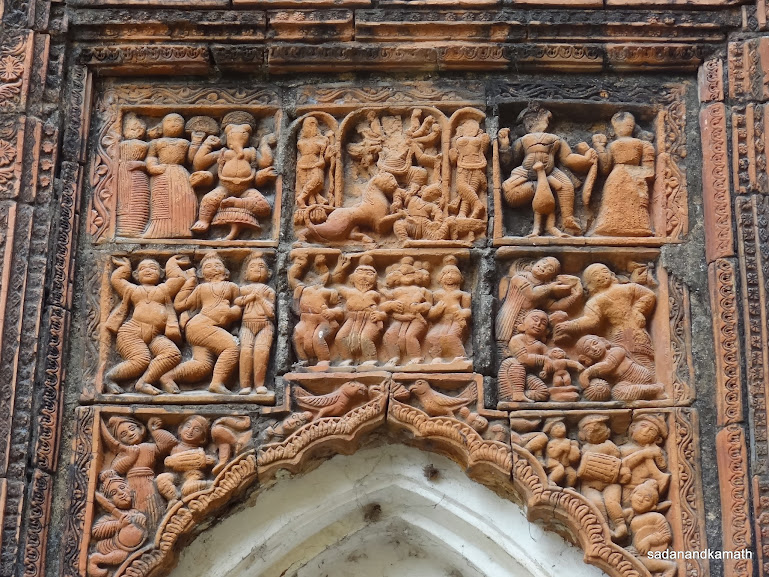 |
| Another terracotta ornamentation on the top of a arched doors of Shiva temple, Surul. |
After completing our scheduled temple visit
to Surul by 10.00 a.m., we proceeded to Barakar requiring a long drive of more
than 100 kms from Surul. Since most of the drive was on 6 lanes NH-2 bypassing
the important industrial cities – Durgapur, Raniganj and Asansol, the drive was fast and smooth. Just
after Asansol, a left turn to the old GT road and a further drive of about 20
kms took us to the main market area of Barakar which is located quite close to
Jharkhand border. The people here speak fluently both Bengali and Hindi. The
temple complex was located somewhere near the market but none of the persons we
asked for direction could tell us properly. After a driving up and down for
nearly 30 minutes, we got a person who could properly give the direction.
After reaching the spot, we realised that we had passed through the lane
leading to the temple complex a couple of times. Had we asked for the direction
of Begunia Bazar temples as locally known, we would have got the correct
direction at the first instance itself.
From the Begunia Bazar, a non-descript lane
of not more than 100m of length ends at the entrance of a large ground where
four temples are located, all constructed on sand stones with shikaras. The
first two temples look identical in its architecture with elaborate stone
carved sculptures. These two are Shiva temples, having five and two shivlings
in the temples on the left and right respectively. A further walk of about 100m
in the open ground took us to two remaining temples. The temple with shikara is
a Shiva temple having 10 shivlings. The fourth temple located close to a tank
is the oldest one dating back to 9th century. Maa Siddheshwari is the
presiding deity of this temple and probably a guardian deity of Barakar town. The
temple priest told me that it was a common practice to sacrifice a goat to appease
the Maa Siddheshwari (form of Maa Kali) on the auspicious occasions like
marriage, birth of a child etc. The priest invited me to join the goat
sacrificing ceremony which was going on at the banks of the tank on the
occasion of the marriage in the family. I declined the offer in the pretext of
getting late to our next destination.
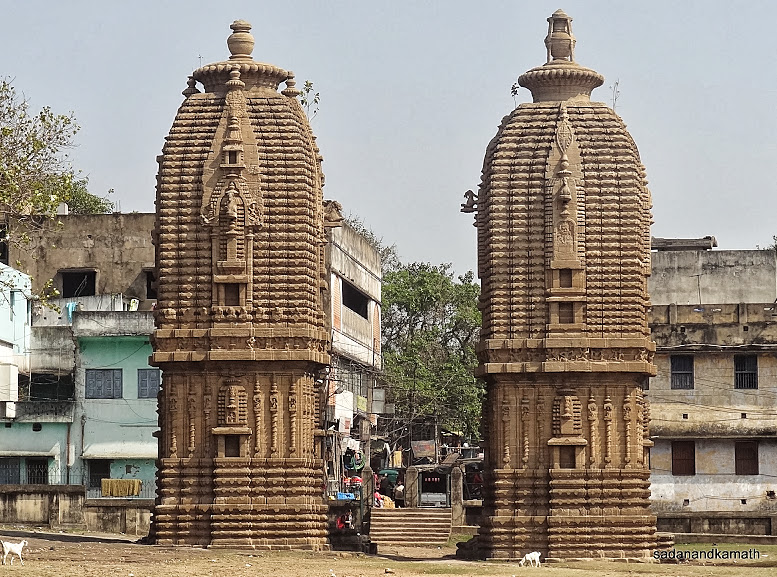 |
Begunia Shiva temples, Barakar.
|
 |
| Stone carvings on on the back of Begunia twin Shiva temples. |
 |
| Begunia temples - the sculptures at the base are of men and women who seems to be holding the weights of shikara with different postures. |
 |
| One more Shiva temple in Begunia complex which have 10 shivlings. |
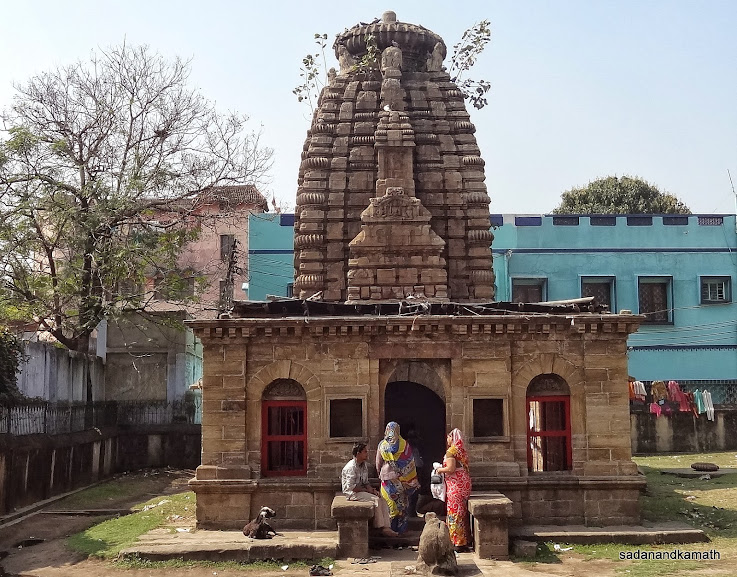 |
| The 9th century Siddheshwari Devi temple in Begunia temple complex. One can call this as a guardian temple of Barakar town. |
 |
| A priest doing a pooja on behalf of a family at the banks of a tank of Siddheshwari temple before sacrificing a goat. The brown coloured 'U' shaped structure on the right is the place where goat's neck would be kept for severing its head in one hit. |
After finishing our day’s schedule of
temple visits at around 1.00 p.m., we thought of having lunch in one of the
hotels in Barakar market. However, as usual, we could not locate any good
hotel. We ate some fruits bought from one of the shops in fruit markets which
was still open despite their afternoon siesta time. We returned to our Guest
House at Shantiniketan at around 5.30 p.m. Once again the cook of the Guest
House was kind enough to prepared some hot onion pakodas to go with our evening tea
and coffee.
In the hindsight, I felt that we could have
booked the Guest House at Shantiniketan for two days and on the third day, we
could have stayed in Durgapur on our return from Barakar for the next day’s
drive to Bishnupur via Sonamukhi. Of course, in terms of the vehicle cost, it
did not matter to us as our contract was in terms of number of days and hours. But we could have saved the rough journey on Illambazar-Panagarh stretch which was full of patholes and some road widneing work was going on.
About
65 years ago (1949-50), Mukul Dey, a student of Gurudev Rabindranath Tagore, ventured
into documenting the terracotta temples of Birbhum district in a very
inhospitable environment when the robberies by the armed gang was the order of the day in this
malaria infested region. He travelled by bullock carts and covered long
distances by walk to visit each and every temples. We are fortunate that we now
have the luxury of travelling by vehicle on good roads and spending nights in
places in comfort to visits these temples
With this, our first leg of the temple tour was over. The next day, we
drove to Bishnupur via Sonamukhi and went on to continue our brick temple hopping for the
next three days which I would cover in a separate blog.
Part-2 : Brick temples of Bishnupur and around.
13 comments:
Thanks for sharing this nice blog..
Indonesia Public Holidays 2015
It is good to see you travel extensively in my State.
Only a small correction....the photograph where you mention "Another twin Shiva temples in Surul" is actually the famous Jora Shiva temple of SUPUR and not SURUL.
Amitabh Guptaji,
Thanks for pointing out the correction. I have changed the caption of the picture accordingly.
Nice trip. Thanks for sharing your trip experience. Science City Kolkata is a plethora of an Amusement Park, a Science Centre and Convention Centre. They have endless activities and exhibits regarding the field of Science. Check out more about Science City.
Thanks for your appreciation, Pothik Magazine.
You just miss Kalyaneshwari Temple near Barakar and a unknown Bishu Temple at Ganrui village at Asansol, (near to NH19)
Post a Comment